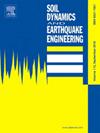Vibration isolation method based on local resonance mechanism for near-field piling in rail transport
IF 4.2
2区 工程技术
Q1 ENGINEERING, GEOLOGICAL
引用次数: 0
Abstract
Environmental vibration from rail transit significantly impacts the lives and livelihoods of people in adjacent areas. This paper proposes a four-component near-field piling vibration isolation method for rail transit based on the local resonance mechanism. It aims to address the issue of the limited distance between certain buildings and the vibration source, as well as the size constraints of piling in traditional isolation schemes. Firstly, the dispersion curve of the four-component periodic structure is derived using the plane wave expansion method, and the factors influencing the attenuation zone of the pile wave barrier are analyzed. Next, the effect of pile row count and pile length on the vibration isolation performance of the wave barrier is evaluated using a three-dimensional finite element model. Finally, the vibration isolation efficiency of the four-component periodic pile method is compared with that of the three-component and two-component methods. The results indicate that the vibration isolation effect of wave barriers improves with an increase in pile rows and lengths. Through comparison, it is found that the four-component periodic pile method exhibits higher vibration isolation efficiency than both the three-component and two-component periodic pile methods when wave barriers of comparable size are used. This approach reduces the required size of wave barriers and presents a novel solution for the vibration isolation in near-field rail transit piling.

基于局部共振机制的铁路运输近场桩的隔振方法
轨道交通产生的环境振动对周边地区居民的生活和生计产生重大影响。提出了一种基于局部共振机理的轨道交通四分量近场桩隔振方法。它旨在解决某些建筑物与振动源之间的距离有限的问题,以及传统隔震方案中桩的尺寸限制。首先,利用平面波展开法推导了四分量周期结构的色散曲线,分析了影响桩波屏障衰减区的因素;其次,采用三维有限元模型分析了桩排数和桩长对隔振性能的影响。最后,比较了四分量周期桩法与三分量和两分量周期桩法的隔振效果。结果表明,随着桩排数和桩长的增加,隔波屏障的隔振效果有所提高。通过比较发现,在同等尺寸的波障条件下,四分量周期桩法比三分量和两分量周期桩法具有更高的隔振效率。该方法减小了所需的波栅尺寸,为近场轨道交通桩的隔振提供了一种新的解决方案。
本文章由计算机程序翻译,如有差异,请以英文原文为准。
求助全文
约1分钟内获得全文
求助全文
来源期刊

Soil Dynamics and Earthquake Engineering
工程技术-地球科学综合
CiteScore
7.50
自引率
15.00%
发文量
446
审稿时长
8 months
期刊介绍:
The journal aims to encourage and enhance the role of mechanics and other disciplines as they relate to earthquake engineering by providing opportunities for the publication of the work of applied mathematicians, engineers and other applied scientists involved in solving problems closely related to the field of earthquake engineering and geotechnical earthquake engineering.
Emphasis is placed on new concepts and techniques, but case histories will also be published if they enhance the presentation and understanding of new technical concepts.
 求助内容:
求助内容: 应助结果提醒方式:
应助结果提醒方式:


